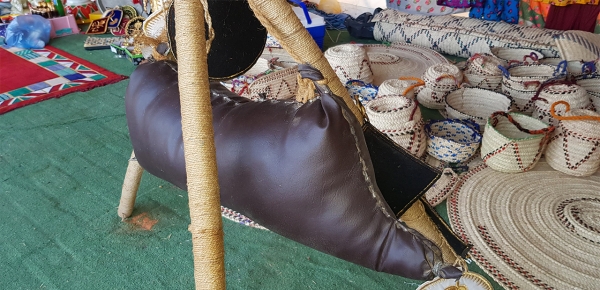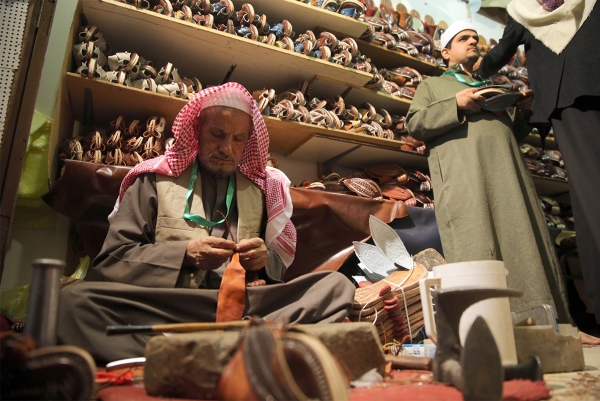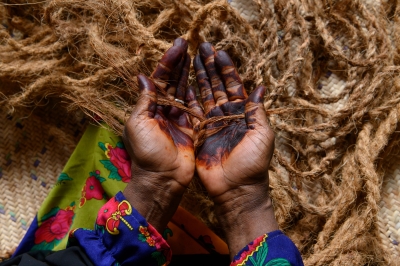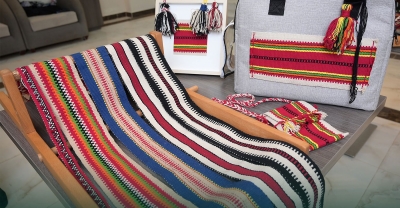


The leather goods in the Kingdom of Saudi Arabia are products and tools whose raw materials rely on leather obtained from livestock (camels, cows, and sheep), as well as leather from hunted animals, such as gazelles and ibexes, in addition to rabbits and spiny-tailed lizards. These leather goods are used in agriculture and household needs in various regions of Saudi Arabia.
Some professions rely on raw materials derived from leather, including tanning and stitching, which are practiced by both men and women. Women, in particular, engage in these professions when the products are for family needs, such as water skins and leather bags. While men undertake production on a commercial scale.
Tanning of leather goods
The first stage of leather production is tanning, which begins by immersing selected hides in vats filled with tannins, such as from corn grains, crushed and fermented barley with water, or lightly cooked dates. The hides remain in these fermenting materials for a week or more until they are fully saturated. They are then removed, their wool is removed, and they are cleaned with a tanner. They are left for four days and turned over from time to time to absorb the tanning agent. Then they are taken out, dried, and smeared with a solution of grease to make them soft and usable.
The materials used in leather tanning vary, with each type giving the tanned leather a distinct color, scent, and tangible softness. Among the most famous substances used in leather tanning are the branches and leaves of the Calligonum tree, known as 'al-Dibagh,' which impart a light red color to the tanned leather. Also used are plants like St. John's wort (Hypericum), which are mountainous trees with small leaves, and they give the tanned leather a deep red color.
Other materials used in tanning include the fruit of the Tamarisk tree, and the branches of the Alhagi plant, a thorny plant that grows abundantly in salt flats and fields. The plant hopbush (Dodonaea) is used for leather tanning in the southern and western provinces. Pomegranate peel is also used for the same purpose, and there are various plants and weeds used in tanning, which vary from one area to another.
Butchers take care to keep the hides free from holes and ensure the skin is clean when separating it from the meat, as this impedes the tanning process. Then the hide is stretched out and salt, alum leaves, or dried and ground straw is placed inside it to absorb water and dissolve the grease from the hide. Then it is immersed in a container or basin filled with water mixed with Dodonaea tree leaves, and the hide remains immersed for a week, being turned several times a day to remove hair and eliminate odor. Afterward, it is removed from the water, cleaned, greased, cleared of suspended particles, exposed to the sun, and then rubbed with ghee or butter to soften it and remove internal protrusions. After that, it is submerged in water with St. John's wort, a short-stemmed mountainous plant, whose roots and wood are pounded and cooked with bitterness and filtered to be placed on leather. After the leather absorbs the St John's wort, it acquires a pleasant smell. If it is being prepared for water storage containers like water skins, pitchers, and buckets, water is left in it for a day or two. Then the water is emptied, and this process is repeated until the bitterness of St John's-wort is removed. If they are not used for water, like for leather bags, saddlebags, pouches, and other items, they are dried and used. The taste of water stored in the water skins changes over time, so they intentionally submerge them in St. John's Wort water again or in Besham water from to remove its salinity and renew its quality.
Manufacturing of buckets
The second stage after tanning is the shaping and stitching of leather products to make the required tools, such as the bucket, which is made from goat, bull, or camel hides. The bucket is a half-oval shaped container called 'al-Qalas,' with two intersecting wooden pieces at the top called 'al-Irqah,' to which the bucket's rope is tied. The bucket is used like water skins to draw water from wells. Later, the bucket started being made from rubber instead of leather. There is a type of bucket made from camel hides, which is larger than regular buckets and is known as 'al-Qalas.'
Manufacturing of water skins
The water skin is made from goat and sheep hides and is used for transporting and cooling water. It is a whole hide stitched from its base, with the places for the sheep's legs and arms sewn or tied, leaving the neck area as the opening for the water skin. The largest and most intact goat and sheep hides, free from holes, are usually chosen for making the water skin. The water skin has a fiber rope wrapped with cloth strips connecting the legs and arms. There may also be two ropes, each connecting a leg to an arm separately. Women collaborate with leatherworkers in making the water skins. Women use ropes to hang the water skin on their shoulders when carrying it to transport water from the well to their homes. They may also place the water skins on the backs of animals if the well is far away. In some areas, fiber ropes are not used to carry the water skins; instead, braided cords and shoulder straps, made from wool, are used. Water skins are used to cool water in the summer. The best ones for cooling are those that have been made several years ago, becoming dry and hard over time. This type is known as 'al-Shinnah.'
Manufacturing of al-Sameel or al-shikwah (water skin) or al-badrah
It is a container similar to the water skin, but smaller in size. It is made from the hides of young sheep or goats. It may not require stitching, as tying (binding) the base of the hide and the openings for the legs and arms can suffice. Al-Sameel is used for churning sour milk. Al-Sameel is either churned by shaking it directly on the legs or by hanging it from a hook or a peg suspended from the ceiling of the house. The water skin is filled up to the top, and the upper half is kept hollow by stretching the sides, allowing it to fill with air. It is then securely tied while inflated to retain this state. Al-Sameel is then shaken until the milk is ready. Once done, the butter is extracted, and the remaining milk is left in al-Sameel, hanging in one corner of the house to be consumed throughout the day. The process is repeated the next day. This task is usually performed by elderly women early in the morning. Al-Sameel is also used by shepherds and travelers to transport and cool water. This type of al-Sameel is known in some provinces, especially in the southwest of Saudi Arabia, as 'al-su'an.'
Manufacturing of 'al-Rakwah'
In the regions of Ghamd and Zahran, a container called 'al-Rakwah' is made from camel neck leather. It serves the same purpose as a modern pitcher. It has an opening through which water is poured in during filling and another from which water is poured out during use. It is smaller than the previous container and has a handle for carrying. To ensure controlled water flow during ablution, a hollow sheep bone may be used as a spout.
There is another type of 'al-Rakwah' that serves as a crib for a child. It is made from leather that has been tanned until it becomes soft. It is about one m long and slightly narrower. Two rods are attached to its ends, with a rope tied to each end of the rods. This cradle is open and spread on the ground, with a small, soft mattress placed inside. The child is placed inside the cradle, which wraps around the upper body, leaving it open at the top. It is hung in a part of the house and rocked until the child falls asleep. In the regions of al-Aflaj and the surrounding areas, it is called 'al-Maizab.' Al-Rakwah is also used to carry the child from one place to another.
Al-Jawa'id manufacturing
Al-Jawa'id is made from the hides of sheep and goats, and there are several types. Some are tanned and have their wool removed, then worn as a vest to protect woodcutters and harvesters. Others are spread on the back of pack animals like saddles and blankets. It is one of the components placed on top of the wooden saddle frame. Al-Jawa'id is typically divided into four equal sections, placed on the camel's back with its hump separating them, and it is stuffed with straw.
Among the types of al-Jawa'id is the 'baby ja'id,' which is placed under a child to prevent urine from leaking through. There are also types that are tanned without removing the wool. These are typically made from large, thick-fleeced sheep hides and are used as seating mats, especially in winter, as they provide warmth. This type is also used to cover the camel's saddle during riding.
Other leather goods
Al-Mirwab is made from leather. It is a large container used for curdling milk before churning. It is placed in a warm location in winter and a cool location in summer until the milk curdles in it. There is also 'al-Ukkah,' a small container similar to al-Sameel, usually made from the hides of young goats or sheep. It is used for storing ghee. There is a type of 'Ukkah' made from the hides of monitor lizards, especially in Najd. It is the smallest of them. The 'Ukkah' is coated with molasses or cooked dates (al-rub) before placing the ghee in it, to prevent it from leaking.
'Al-Nahu' is similar in shape and use to 'al-Ukkah,' but it is larger in size. There is also 'al-Makrash,' a leather container used to store butter after it is taken from the al-Sameel after churning. Al-Rawiyah' is made from camel hides and resembles the water skin but is larger in size and usually square-shaped. Al-Rawiyah has a neck at the top and two handles on either side for carrying. Al-Rawiyah serves the same purpose as the water skin in transporting water, especially in the desert. However, it is not suitable for cooling water. 'Al-Aybah' is also made from camel hides, is square-shaped, and has two handles. It is used to store dates and other foods
Al-Hawd is one of the largest items made from camel hides. It is a large container that may be crafted from several hides stitched together and fixed onto wooden supports. It is placed near the well and filled with water for camels and livestock to drink from. Leather, especially camel hides, is also used to make ropes and leather strips called 'al-Qad,' which are used to tie and reinforce various wooden items such as fences, doors, and structures. One type of leather rope is 'Habl al-Sarih' (al-Miqat), one of the two ropes used to lift water skins from the well.
As for the 'Julmud,' which is the smallest tendon in the camel's neck, it is straightened and wrapped, then left to dry. When needed, a small amount of clay is mixed, and the Julmud is buried in it for a day or two. During this period, it is occasionally watered until it becomes soft. The Julmud is used to bind valuable items, such as rifles, due to its beauty and strength. It is considered superior to 'al-Qad.'
Leather is also used in other crafts, such as making shoes (sandals), belts, gun covers, and 'al-Duff,' which women use as a drum during wedding celebrations and festivals. Men use drums and Damamim in al-Ardah and Samri performances. 'Al-Haskal' is also made from leather. It is a container for carrying money and straps, resembling the shape of a gun holster. It is fastened with a braided leather strap, allowing it to be worn around the body so that the 'Haskal' hangs under the left armpit, with its belt or braid resting on the right shoulder.
Similarly, 'al-Maysab' is made from leather. It resembles 'al-Ukkah' but is larger and is used for storing honey. There is also al-Simat, a container used by travelers to carry their belongings, and it comes in two types. Additionally, there is 'al-Qadha,' a skirt made of leather strips that girls under the age of ten used to wear. Al-Jirab is a container used to store grains, dates, and flour. Al-Haqu' or 'Nas'ah' is a leather belt for men, worn either over or under their clothes. The 'Nata' is used for collecting flour, placed under the millstone. Al-Qaabil is a container larger than the 'Simat,' carried on the back, and sometimes two Qabīls are paired on livestock like saddle bags. Various other bags and containers are also made from leather to carry money, coffee, cups, and other lightweight items. Various shapes are also made from leather strips for many purposes. The leather and strips can be dyed and used to decorate leather goods.
Related quizzes
Related articles

